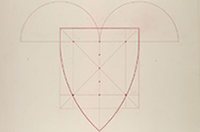Ruskin's Rudimentary series, 3rd ed. (1872)
Items marked 'M' are drawings "by my own Hand" (by Ruskin), P are photographs, E engravings and A by Ruskin's Assistant, Arthur Burgess.

Ruskin's General Arrangement of rooms
I.GENERAL ARRANGEMENT OF THE ROOMS AND OF THE COLLECTIONS CONTAINED IN THEM.
The north extremity of the lower room in the University galleries, including the semicircular alcove on the west side, is set apart for members of the University, and contains the Educational Series (now complete), in the small cabinets, and the chief portion of the Reference Series, in the eight large cabinets placed round the alcove.
For the present, the Standard Series, being few in number, is included in the Reference Series. If, therefore, a drawing is referred to as Edu. 1, or Edu. 2, and the like, it is in one of the twelve small cabinets in the northern division of the rooms. If noted as Ref. 1, Ref. 2, &c., it is in one of the large cabinets. But if as R. 1, R. 2, &c., it is of the Rudimentary Series; and is in one of the twelve small cabinets in the southern division of the room reserved for general students.
The Turner drawings in the Educational and Reference Series, Ref. 2, Ref. 3, and Edu. 140, are of the highest interest and value. It will not, I hope, be attributed to ostentation, if I state what I think should be known as an indication of the real quality of the drawings, that Ref. 2 cost me 500 guineas, and Edu. 140, small as it is, 650. It will be ultimately placed in the Reference Series, as it is seen to the greatest disadvantage in its wooden frame. Other Turner drawings in the Educational Series, and, in the Rudimentary, 14, 126, 127, and 300, are of very great interest; but the student is requested at once to note that the vignettes R. 145, R. 146, R. 147, R 148, and R. 149, are only copies of the vignettes by Turner in the National Gallery. They are executed with admirable skill by my assistant, Mr. Ward, and will be of great service to us, but they must be distinguished carefully from the real Turners in the series.
R. 300 is unique, as far as I know, among Turner’s sepia sketches, for its grace and ease, and there is no drawing in body colour, in the national collections, altogether, equal to Ref. 3, in the qualities characteristic of Turner at his finest period.
In the alcove, I have placed one of my own studies from a fresco of Luini’s at Milan; with two original designs by Edward Burne Jones, “Love bringing back Alcestis from the Grave,” and “The Two Wives of Jason.” These two drawings, and the original of my study, are consummate in dignity and purity of conception, and the best examples I can give of the forms of highest art which I think should be held, for standard, and scope, by English students.
On the west side of this portion of the room set apart for the Rudimentary school, is Tintoret’s sketch for his picture of the “Doge Alvise Mocenigo praying.” The picture is in the Ducal Palace of Venice. This sketch, once belonging to Baron Rumohr, is full of interest and exemplary qualities. The other paintings or drawings on the walls are for the illustration of architecture; except the Copley Fielding at the end of the room , which is an interesting and not uninstructive example of water-colour-painting of the old school .
None of these paintings or drawings are, as yet, formally presented to, or accepted by, the University. Some do not deserve any permanent position; and I retain for the present the power of removing any of them, either for the substitution of others, or for my own occasional use; but if the Collections are found serviceable in the form ultimately proposed for them, and the system of teaching in accordance with which they have been arranged is sanctioned by the approval of the University, and recognized as a part of its educational curriculum, the entire series of examples would, of course—so far as I am concerned—remain absolutely at the disposal of the University authorities.




